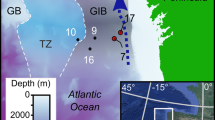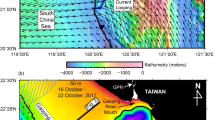Abstract
Sedimentary furrows in fine-grained sediments have been observed in a variety of settings ranging from the deep ocean and deep lake bottoms to shallow estuaries and are commonly described as persistent, long-term features of the seabed. A series of 12 sidescan sonar surveys over the course of three years reveal that transient, longitudinal sedimentary furrows regularly form and then occasionally dissipate within the middle portion of the York River. Varying furrow morphologies were observed depending on current conditions, ranging from large regularly space (0.7–7 m) linear furrows during low current conditions to large patches of meandering furrows as the mean current increases or no bed forms during the higher current conditions. Based on210Pb and137Cs profiles of kasten cores, differences in physical mixing depths of ∼25 cm between cores collected <2 m apart indicate a high degree of small-scale spatial heterogeneity within the seabed. By documenting the position of kasten cores using a digital sidescan sonar system, we showed that a core taken within a furrow had a mixing depth 15 cm shallower than an adjacent core taken between furrows. A time-series of mixing depths over the 35 mo of the study reveals that, along with the ∼25 cm scale differences in mixing depths due to the formation and destruction of furrows, there is a longer temporal signal of mixing producing 100-cm-scale changes in mixing depths on the annual to interannual time frame. Although the formation and destruction of the furrows appear to be a significant process contributing to decimeter-scale seabed mixing, there is a longer-term unknown process which is controlling the meter-scale seabed mixing.
Similar content being viewed by others
Literature Cited
Allen, J. R. L. 1969. Erosional current marks of weakly cohesive mud beds.Journal of Sedimentary Petrology 39:607–623.
Carron, M. J. 1976. Geomorphic processes of a drowned river valley: Lower York River Estuary, Virginia. M.S. Thesis, Virginia Institute of Marine Science, Gloucester Point, Virginia.
Cochonat, P., G. Ollier, andJ. L. Michel. 1989. Evidence for slope instability and current induced sediment transport, the RMSTitanic wreck search area, Newfoundland Rise.Geo-Marine Letters 9:145–152.
Coleman, J. M., D. B. Prior, andC. E. Adams, Jr. 1981. Erosional furrows on continental shelf edge, Mississippi delta region.GeoMarine Letters 1:11–15.
Dauer, D. M., R. M. Ewing, J. A. Ranasinghe, andA. J. Rodi, Jr. 1989. Macrobenthic Communities of the Lower Chesapeake Bay. Chesapeake Bay Program. Progress Report. Fourteen Cruises, for the period March 1985 through June 1988, prepared for Virginia Water Control Board, Chesapeake Bay Program. Old Dominion University Research Foundation. Norfolk, Virginia.
Dellapenna, T. M. 1999. Fine-scale strate formation in biologically and physically dominated estuarine systems within the Lower Chesapeake and York River subestuaries. Ph.D. Dissertation, Virginia Institute of Marine Science, College of William and Mary, Gloucester Point, Virginia.
Dellapenna, T. M., S. A. Kuehl, andL. C. Schaffner. 1998. Seabed mixing and particle residence times in biologically and physically dominated estuarine systems: A comparison of lower Cheaspeake Bay and the York River subestuary.Estuarine, Coastal and Shelf Science 46:777–795.
Dyer, K. R. 1970. Linear erosional furrows in Southampton Water.Nature 255:56–58.
Dzulynski, S. 1965. New data on experimental production of sedimentary structures.Journal of Sedimentary Petrology 35:196–212.
Embley, R. W., P. L. Hoose, P. Lonsdale, L. Mayer, andB. E. Tucholke. 1980. Furrow mud waves on the western Bermuda Rise.Bulletin of the Geological Society of America 91:731–740.
Embley, R. W., P. D. Rabinowitz, andR. D. Jacobi. 1978. Hyperbolic echo zones in the eastern Atlantic and the structure of the southern Madeira Rise.Earth and Planet Letters 41:419–433.
Flood, R. D. 1978. Studies of Deep-sea Sedimentary Microtopography in the North Atlantic Ocean. Massachusetts Institute of Technology-Woods Hole Oceanographic Institute Joint Program Technical Report WHOI-78-64. Woods Hole, Massachusetts.
Flood, R. D. 1981. Distribution, morphology, and origin of sedimentary furrows in cohesive sediments, Southampton Water.Sedimentology 28:511–529.
Flood, R. D. 1983. Classification of sedimentary furrows and a model for furrow initiation and evolution.Bulletin of the Geological Society of America 94:630–639.
Flood, R. D. 1989. Submersible studies of current-modified bottom topography in Lake Superior.Journal of Great Lakes Research 15:3–14.
Flood, R. D. andH. J. Bokuniewicz. 1986. Bottom morphology in the Hudson River and New York Harbor.Northeastern Geology 8:130–140.
Flood, R. D. andC. D. Hollister. 1980. Submersible studies of deep sea furrows and transverse ripples in cohesive sediments.Marine Geology 36:M1-M9.
Flood, R. D. andT. C. Johnson. 1984. Side-scan sonar targets in Lake Superior-Evidence for bed forms and sediment transport.Sedimentology 31:311–333.
Holland, A. F., A. T. Shaughnessy, andM. H. Hiegel. 1987. Long-term variation in mesohaline Chesapeake Bay macrobenthos: Spatial and temporal patterns.Estuaries 10:227–245.
Hollister, C. D., R. D. Flood, D. A. Johnson, P. F. Lonsdale, andJ. B. Southard. 1974. Abyssal furrows and hyperbolic echo traces on the Bahama Outer Ridge.Geology 2:395–400.
Johnson, T. C., T. W. Carison, andJ. E. Evans. 1980. Contourites in Lake Superior.Geology 8:437–441.
Kim, S. C., C. T. Friedrichs, J. P.-Y. Maa, andL. D. Wright. 2000. Estimating bottom stress in a tidal boundary layer from Acoustic Doppler velocimeter data.Journal of Hydraulic Engineering 126:399–406.
Krishnaswami, S., D. Lal, J. M. Martin, andM. Meybeck. 1971. Geochronology of lake sediments.Earth and Planetary Science Letters 11:407–414.
Lonsdale, P. F. 1978. Bed Forms and the Benthic Boundary Layer in the North Atlantic: A Cruise Report of Indomed, Leg 11: Scripps Institution of Oceanography Reference 78-30. Scripps Institute of Oceanography, La Jolla, California.
Lonsdale, P. F., F. N. Spiess, andJ. D. Mudie. 1973. Erosional furrows across the abyssal Pacific floor.EOS (American Geophysical Union Transactions) 54:1110.
Nittrouer, C. A., R. W. Sternberg, R. Carpenter, andJ. T. Bennett. 1979. the use of210Pb geochronology as a sedimentological tool: Application to the Washington continental shelf.Marine Geology 31:297–316.
Robbins, J. A. andD. N. Edgington. 1975. Determination of recent sedimentation rates in Lake Michigan using210Pb and137Cs.Geochimica et Cosmochimica Acta 39:285–304.
Schaffner, L. C., T. M. Dellapenna, E. Hinchey, C. Friedrichs, M. Thompson-Neubauer, M. E. Smith, and S. A. Kuehl. In press. Physical energy regimes, seabed dynamics, and organism-sediment interactions along an estuarine gradient: Implications for ecosystem structure and function.In J. Y. Aller, R. Aller, and S. A. Woodin (eds.), Organism-Sediment Interactions, A Special Volume of Workshop Proceedings, October 1998. University of South Carolina Press.
Viekman, B. E., R. D. Flood, M. Wimbush, M. Faghri, Y. Asako, andJ. C. Van Leer. 1992. Sedimentary furrows and organized flow structure: A study in Lake Superior.Limnology Oceanography 37:797–812.
Viekman, B. E., M. Wimbush, andJ. C. Van Leer. 1989. Secondary circulations in the bottom layer over sedimentary furrows.Journal of Geophysical Research 94:9721–9730.
Wright, L. D., L. C. Schaffner, C. T. Friedrichs, and J. P.-Y. Maa. 1996. Variability of Bottom Boundary Layer Processes and Bed Response in the Lower Chesapeake Bay and Adjoining Estuaries. American Limnological Scientist Organization, American Geophysical Union 1996 Ocean Sciences Meeting. San Diego, California.
Sources of Unpublished Materials
Maa, J. P.-Y. Personal Communication. Virginia Institute of Marine Science, College of William and Mary, Gloucester Point, Virinia 23063.
Wright, L. D. Personal Communication. Virginia Institute of Marine Science, College of William and Mary, Gloucester Point, Virinia 23063.
Author information
Authors and Affiliations
Corresponding author
Rights and permissions
About this article
Cite this article
Dellapenna, T.M., Kuehl, S.A. & Pitts, L. Transient, longitudinal, sedimentary furrows in the York River subestuary, Chesapeake Bay: Furrow evolution and effects on seabed mixing and sediment transport. Estuaries 24, 215–227 (2001). https://doi.org/10.2307/1352946
Received:
Accepted:
Issue Date:
DOI: https://doi.org/10.2307/1352946




